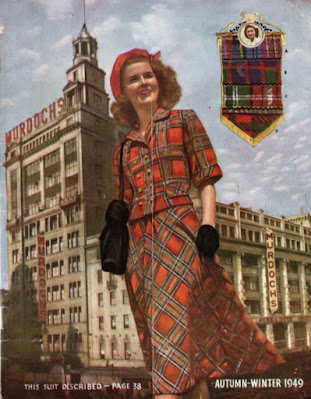Sometimes a topic for a blog entry just presents itself. This time it was when I noticed that these two department stories featured very similar outfits on the covers of their catalogues for Autumn-Winter 1949. Clearly bright red plaid was in that season!
Firstly, from Murdochs of Sydney: a "lightweight, all-wool tartan" Middy suit. The version illustrated on the cover is in Princess Elizabeth tartan, but the same suit could also be purchased in Macpherson, Red Fraser, Macbeth and Princess Margaret tartans.
From the inside back cover of the same catalogue: a "gay WOOL FROCK" in a choice of four tartans, and on the right, a woollen pullover worn with an "All-Wool TARTAN SKIRT with full circular swirl."
Myer in Melbourne was also getting into the Tartan Trend, with a skirt of English (my emphasis) "all wool authentic tartan with myriad knife pleats". The model on the cover is dressed in Royal Stewart tartan, but the same skirt could be bought in Princess Elizabeth, Princess Margaret Rose, Buchanan, King George VI and Duchess of Kent tartans.
So there you have it: wherever they lived, the women of Australia could count on being well-dressed if they wore tartan in winter 1949!











